Product Info Summary
| SKU: | M00036-2 |
|---|---|
| Size: | 100 μg/vial |
| Reactive Species: | Human, Monkey |
| Host: | Mouse |
| Application: | Flow Cytometry, IF, IHC, ICC, WB |
Customers Who Bought This Also Bought
Product info
Product Name
Anti-STAT1 Antibody Picoband® (monoclonal, 12C7)
SKU/Catalog Number
M00036-2
Size
100 μg/vial
Form
Lyophilized
Description
Boster Bio Anti-STAT1 Antibody Picoband® (monoclonal, 12C7) catalog # M00036-2. Tested in Flow Cytometry, IF, IHC, ICC, WB applications. This antibody reacts with Human, Monkey. The brand Picoband indicates this is a premium antibody that guarantees superior quality, high affinity, and strong signals with minimal background in Western blot applications. Only our best-performing antibodies are designated as Picoband, ensuring unmatched performance.
Storage & Handling
Store at -20˚C for one year from date of receipt. After reconstitution, at 4˚C for one month. It can also be aliquotted and stored frozen at -20˚C for six months. Avoid repeated freeze-thaw cycles.
Cite This Product
Anti-STAT1 Antibody Picoband® (monoclonal, 12C7) (Boster Biological Technology, Pleasanton CA, USA, Catalog # M00036-2)
Host
Mouse
Contents
Each vial contains 4mg Trehalose, 0.9mg NaCl, 0.2mg Na2HPO4, 0.05mg NaN3.
Clonality
Monoclonal
Clone Number
12C7
Isotype
Mouse IgG1
Immunogen
E.coli-derived human STAT1 recombinant protein (Position: S2-A230). Human STAT1 shares 91.2% amino acid (aa) sequence identity with mouse STAT1.
*Blocking peptide can be purchased. Costs vary based on immunogen length. Contact us for pricing.
Cross-reactivity
No cross-reactivity with other proteins.
Reactive Species
M00036-2 is reactive to STAT1 in Human, Monkey
Reconstitution
Add 0.2ml of distilled water will yield a concentration of 500μg/ml.
Observed Molecular Weight
91 kDa
Calculated molecular weight
14377 MW
Background of STAT1
Signal transducer and activator of transcription 1 (STAT1) is a transcription factor which in humans is encoded by the STAT1 gene. The protein encoded by this gene is a member of the STAT protein family. In response to cytokines and growth factors, STAT family members are phosphorylated by the receptor associated kinases, and then form homo- or heterodimers that translocate to the cell nucleus where they act as transcription activators. This protein can be activated by various ligands including interferon-alpha, interferon-gamma, EGF, PDGF and IL6. This protein mediates the expression of a variety of genes, which is thought to be important for cell viability in response to different cell stimuli and pathogens. Two alternatively spliced transcript variants encoding distinct isoforms have been described.
Antibody Validation
Boster validates all antibodies on WB, IHC, ICC, Immunofluorescence, and ELISA with known positive control and negative samples to ensure specificity and high affinity, including thorough antibody incubations.
Application & Images
Applications
M00036-2 is guaranteed for Flow Cytometry, IF, IHC, ICC, WB Boster Guarantee
Assay Dilutions Recommendation
The recommendations below provide a starting point for assay optimization. The actual working concentration varies and should be decided by the user.
Western blot, 0.1-0.5μg/ml
Immunohistochemistry (Paraffin-embedded Section), 0.5-1μg/ml
Immunocytochemistry/Immunofluorescence, 2μg/ml
Flow Cytometry (Fixed), 1-3μg/1x106 cells
Positive Control
WB: human Hela whole cell, human placenta tissue, human 22RV1 whole cellmonkey COS-7 whole cell, human SW620 whole cell, human HepG2 whole cell, human PANC-1 whole cell
IHC: human intestinal cancer tissue, human intestinal cancer tissue, human mammary cancer tissue, human tonsil tissue
FCM: A431 cell
Validation Images & Assay Conditions
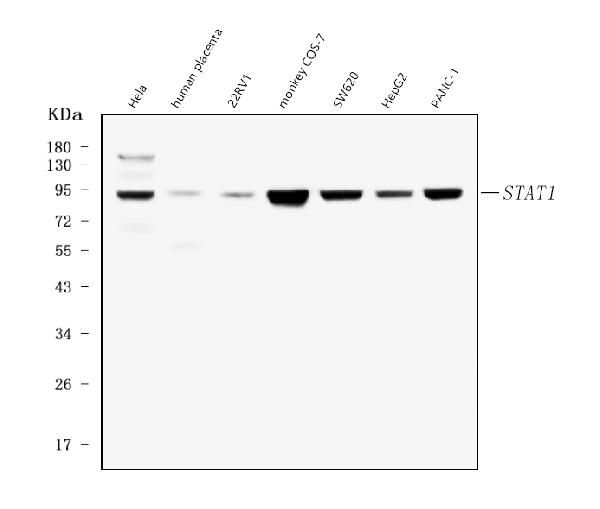
Click image to see more details
Figure 1. Western blot analysis of STAT1 using anti-STAT1 antibody (M00036-2).
Electrophoresis was performed on a 5-20% SDS-PAGE gel at 70V (Stacking gel) / 90V (Resolving gel) for 2-3 hours. The sample well of each lane was loaded with 50ug of sample under reducing conditions.
Lane 1: human Hela whole cell lysates,
Lane 2: human placenta tissue lysates,
Lane 3: human 22RV1 whole cell lysates.
Lane 4: monkey COS-7 whole cell lysates,
Lane 5: human SW620 whole cell lysates,
Lane 6: human HepG2 whole cell lysates,
Lane 7: human PANC-1 whole cell lysates.
After Electrophoresis, proteins were transferred to a Nitrocellulose membrane at 150mA for 50-90 minutes. Blocked the membrane with 5% Non-fat Milk/ TBS for 1.5 hour at RT. The membrane was incubated with mouse anti-STAT1 antigen affinity purified monoclonal antibody (Catalog # M00036-2) at 0.5 μg/mL overnight at 4°C, then washed with TBS-0.1%Tween 3 times with 5 minutes each and probed with a goat anti-mouse IgG-HRP secondary antibody at a dilution of 1:10000 for 1.5 hour at RT. The signal is developed using an Enhanced Chemiluminescent detection (ECL) kit (Catalog # EK1001) with Tanon 5200 system. A specific band was detected for STAT1 at approximately 91KD. The expected band size for STAT1 is at 87KD.
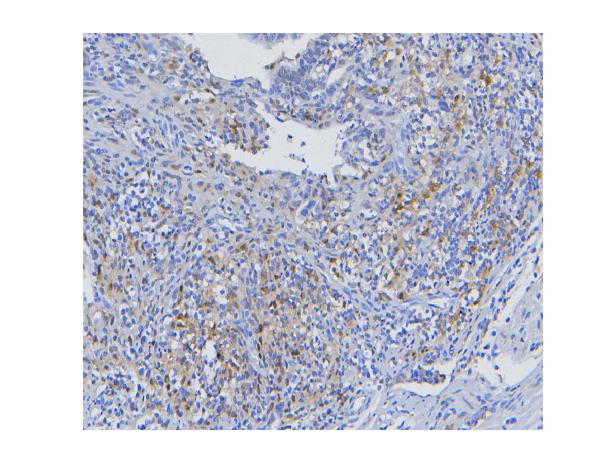
Click image to see more details
Figure 2. IHC analysis of STAT1 using anti STAT1 antibody (M00036-2).
STAT1 was detected in paraffin-embedded section of human intestinal cancer tissue. Heat mediated antigen retrieval was performed in EDTA buffer (pH8.0, epitope retrieval solution). The tissue section was blocked with 10% goat serum. The tissue section was then incubated with 1μg/ml mouse anti-STAT1 Antibody (M00036-2) overnight at 4°C. Biotinylated goat anti-mouse IgG was used as secondary antibody and incubated for 30 minutes at 37°C. The tissue section was developed using Strepavidin-Biotin-Complex (SABC) (Catalog # SA1021) with DAB as the chromogen.
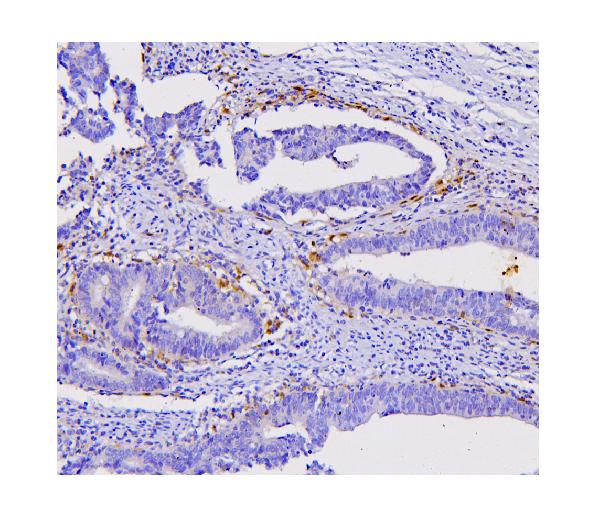
Click image to see more details
Figure 3. IHC analysis of STAT1 using anti STAT1 antibody (M00036-2).
STAT1 was detected in paraffin-embedded section of human intestinal cancer tissue. Heat mediated antigen retrieval was performed in EDTA buffer (pH8.0, epitope retrieval solution). The tissue section was blocked with 10% goat serum. The tissue section was then incubated with 1μg/ml mouse anti-STAT1 Antibody (M00036-2) overnight at 4°C. Biotinylated goat anti-mouse IgG was used as secondary antibody and incubated for 30 minutes at 37°C. The tissue section was developed using Strepavidin-Biotin-Complex (SABC) (Catalog # SA1021) with DAB as the chromogen.
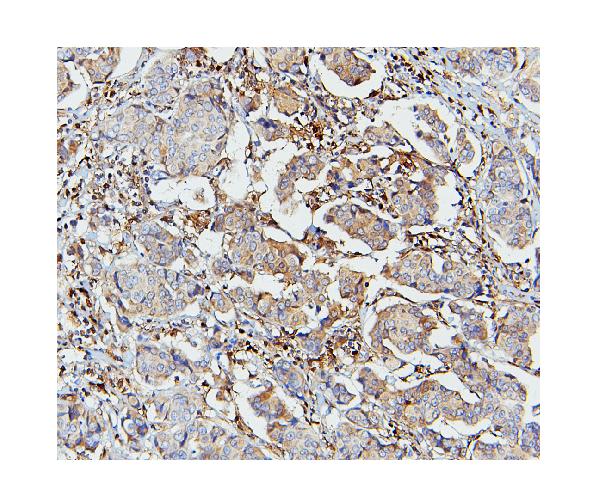
Click image to see more details
Figure 4. IHC analysis of STAT1 using anti STAT1 antibody (M00036-2).
STAT1 was detected in paraffin-embedded section of human mammary cancer tissue. Heat mediated antigen retrieval was performed in EDTA buffer (pH8.0, epitope retrieval solution). The tissue section was blocked with 10% goat serum. The tissue section was then incubated with 1μg/ml mouse anti-STAT1 Antibody (M00036-2) overnight at 4°C. Biotinylated goat anti-mouse IgG was used as secondary antibody and incubated for 30 minutes at 37°C. The tissue section was developed using Strepavidin-Biotin-Complex (SABC) (Catalog # SA1021) with DAB as the chromogen.
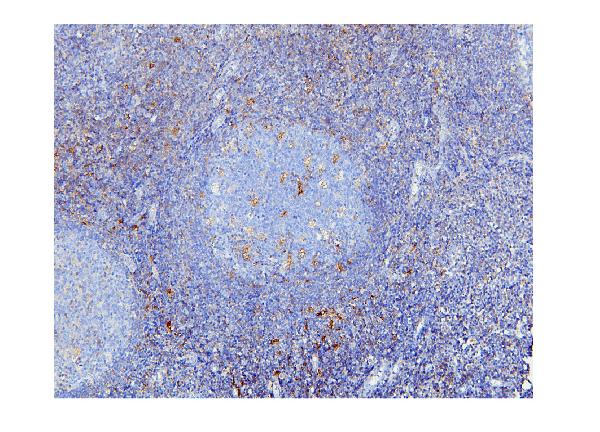
Click image to see more details
Figure 5. IHC analysis of STAT1 using anti STAT1 antibody (M00036-2).
STAT1 was detected in paraffin-embedded section of human tonsil tissue. Heat mediated antigen retrieval was performed in EDTA buffer (pH8.0, epitope retrieval solution). The tissue section was blocked with 10% goat serum. The tissue section was then incubated with 1μg/ml mouse anti-STAT1 Antibody (M00036-2) overnight at 4°C. Biotinylated goat anti-mouse IgG was used as secondary antibody and incubated for 30 minutes at 37°C. The tissue section was developed using Strepavidin-Biotin-Complex (SABC) (Catalog # SA1021) with DAB as the chromogen.
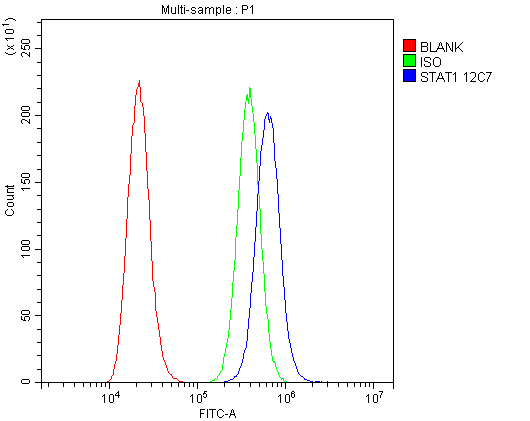
Click image to see more details
Figure 6. Flow Cytometry analysis of A431 cells using anti- STAT1 antibody (M00036-2).
Overlay histogram showing A431 cells stained with M00036-2 (Blue line). To facilitate intracellular staining, cells were fixed with 4% paraformaldehyde and permeabilized with permeabilization buffer. The cells were blocked with 10% normal goat serum. And then incubated with mouse anti-STAT1 Antibody (M00036-2, 1μg/1x106 cells) for 30 min at 20°C. DyLight®488 conjugated goat anti-mouse IgG (BA1126, 5-10μg/1x106 cells) was used as secondary antibody for 30 minutes at 20°C. Isotype control antibody (Green line) was mouse IgG (1μg/1x106) used under the same conditions. Unlabelled sample without incubation with primary antibody and secondary antibody (Red line) was used as a blank control.
Protein Target Info & Infographic
Gene/Protein Information For STAT1 (Source: Uniprot.org, NCBI)
Gene Name
STAT1
Full Name
Signal transducer and activator of transcription 1-alpha/beta
Weight
14377 MW
Superfamily
transcription factor STAT family
Alternative Names
Signal transducer and activator of transcription 1-alpha/beta; Transcription factor ISGF-3 components p91/p84; STAT1 STAT1 CANDF7, IMD31A, IMD31B, IMD31C, ISGF-3, STAT91 signal transducer and activator of transcription 1 signal transducer and activator of transcription 1-alpha/beta|signal transducer and activator of transcription 1, 91kD|signal transducer and activator of transcription 1, 91kDa|transcription factor ISGF-3 components p91/p84
*If product is indicated to react with multiple species, protein info is based on the gene entry specified above in "Species".For more info on STAT1, check out the STAT1 Infographic

We have 30,000+ of these available, one for each gene! Check them out.
In this infographic, you will see the following information for STAT1: database IDs, superfamily, protein function, synonyms, molecular weight, chromosomal locations, tissues of expression, subcellular locations, post-translational modifications, and related diseases, research areas & pathways. If you want to see more information included, or would like to contribute to it and be acknowledged, please contact [email protected].
Specific Publications For Anti-STAT1 Antibody Picoband® (monoclonal, 12C7) (M00036-2)
Hello CJ!
M00036-2 has been cited in 5 publications:
*The publications in this section are manually curated by our staff scientists. They may differ from Bioz's machine gathered results. Both are accurate. If you find a publication citing this product but is missing from this list, please let us know we will issue you a thank-you coupon.
Hepatitis C Virus non-structural 5A abrogates signal transducer and activator of transcription-1 nucleartranslocation induced by IFN-α through dephosphorylation
Blockage of Glyoxalase I Inhibits Colorectal Tumorigenesis and Tumor Growth via Upregulation of STAT1, p53, and Bax and Downregulation of c-Myc and Bcl-2
Effects of acitretin on proliferative inhibition and RANTES production of HaCaT cells
Synergistic inhibition of colon cancer growth by the combination of methylglyoxal and silencing of glyoxalase I mediated by the STAT1 pathway
Hepatitis C virus non-structural 5A abrogates signal transducer and activator of transcription-1 nuclear translocation induced by IFN-alpha through dephosphorylation.
Recommended Resources
Here are featured tools and databases that you might find useful.
- Boster's Pathways Library
- Protein Databases
- Bioscience Research Protocol Resources
- Data Processing & Analysis Software
- Photo Editing Software
- Scientific Literature Resources
- Research Paper Management Tools
- Molecular Biology Software
- Primer Design Tools
- Bioinformatics Tools
- Phylogenetic Tree Analysis
Customer Reviews
Have you used Anti-STAT1 Antibody Picoband® (monoclonal, 12C7)?
Submit a review and receive an Amazon gift card.
- $30 for a review with an image
0 Reviews For Anti-STAT1 Antibody Picoband® (monoclonal, 12C7)
Customer Q&As
Have a question?
Find answers in Q&As, reviews.
Can't find your answer?
Submit your question
15 Customer Q&As for Anti-STAT1 Antibody Picoband® (monoclonal, 12C7)
Question
Will anti-STAT1 antibody (monoclonal, 12C7) M00036-2 work for IHC-P with cervix carcinoma erythroleukemia?
A. Zhang
Verified customer
Asked: 2020-05-06
Answer
According to the expression profile of cervix carcinoma erythroleukemia, STAT1 is highly expressed in cervix carcinoma erythroleukemia. So, it is likely that anti-STAT1 antibody (monoclonal, 12C7) M00036-2 will work for IHC-P with cervix carcinoma erythroleukemia.
Boster Scientific Support
Answered: 2020-05-06
Question
We are currently using anti-STAT1 antibody (monoclonal, 12C7) M00036-2 for monkey tissue, and we are satisfied with the IHC-P results. The species of reactivity given in the datasheet says human, monkey. Is it possible that the antibody can work on dog tissues as well?
Verified Customer
Verified customer
Asked: 2020-04-30
Answer
The anti-STAT1 antibody (monoclonal, 12C7) (M00036-2) has not been tested for cross reactivity specifically with dog tissues, but there is a good chance of cross reactivity. We have an innovator award program that if you test this antibody and show it works in dog you can get your next antibody for free. Please contact me if I can help you with anything.
Boster Scientific Support
Answered: 2020-04-30
Question
We have observed staining in monkey cervix carcinoma. What should we do? Is anti-STAT1 antibody (monoclonal, 12C7) supposed to stain cervix carcinoma positively?
Verified Customer
Verified customer
Asked: 2020-02-21
Answer
From literature cervix carcinoma does express STAT1. From Uniprot.org, STAT1 is expressed in epithelium of bronchus, placenta testis, brain, b-cell, cervix carcinoma, leukemic t-cell, cervix carcinoma erythroleukemia, liver, among other tissues. Regarding which tissues have STAT1 expression, here are a few articles citing expression in various tissues:
B-cell, Pubmed ID: 9724754
Brain, Pubmed ID: 15489334
Cervix carcinoma, Pubmed ID: 18669648, 18691976, 20068231
Cervix carcinoma, and Erythroleukemia, Pubmed ID: 23186163
Leukemic T-cell, Pubmed ID: 19690332
Liver, Pubmed ID: 24275569
Placenta, and Testis, Pubmed ID: 14702039
Boster Scientific Support
Answered: 2020-02-21
Question
We appreciate helping with my inquiry over the phone. Here are the WB image, lot number and protocol we used for cervix carcinoma erythroleukemia using anti-STAT1 antibody (monoclonal, 12C7) M00036-2. Let me know if you need anything else.
Verified Customer
Verified customer
Asked: 2020-01-28
Answer
I appreciate the data. You have provided everything we needed. Our lab team are working to resolve your inquiry as quickly as possible, and we appreciate your patience and understanding! Please let me know if there is anything you need in the meantime.
Boster Scientific Support
Answered: 2020-01-28
Question
Is a blocking peptide available for product anti-STAT1 antibody (monoclonal, 12C7) (M00036-2)?
Verified Customer
Verified customer
Asked: 2019-09-06
Answer
We do provide the blocking peptide for product anti-STAT1 antibody (monoclonal, 12C7) (M00036-2). If you would like to place an order for it please contact [email protected] and make a special request.
Boster Scientific Support
Answered: 2019-09-06
Question
I have attached the WB image, lot number and protocol we used for cervix carcinoma erythroleukemia using anti-STAT1 antibody (monoclonal, 12C7) M00036-2. Please let me know if you require anything else.
Verified Customer
Verified customer
Asked: 2019-05-20
Answer
Thank you very much for the data. Our lab team are working to resolve this as quickly as possible, and we appreciate your patience and understanding! You have provided everything we needed. Please let me know if there is anything you need in the meantime.
Boster Scientific Support
Answered: 2019-05-20
Question
Our lab used your anti-STAT1 antibody (monoclonal, 12C7) for IF on epithelium of bronchus a few years ago. I am using monkey, and I plan to use the antibody for Flow Cytometry next. My question regards examining epithelium of bronchus as well as placenta testis in our next experiment. Do you have any suggestion on which antibody would work the best for Flow Cytometry?
Verified Customer
Verified customer
Asked: 2019-03-15
Answer
I have checked the website and datasheets of our anti-STAT1 antibody (monoclonal, 12C7) and it seems that M00036-2 has been validated on monkey in both IF and Flow Cytometry. Thus M00036-2 should work for your application. Our Boster satisfaction guarantee will cover this product for Flow Cytometry in monkey even if the specific tissue type has not been validated. We do have a comprehensive range of products for Flow Cytometry detection and you can check out our website bosterbio.com to find out more information about them.
Boster Scientific Support
Answered: 2019-03-15
Question
Our lab want to know about to test anti-STAT1 antibody (monoclonal, 12C7) M00036-2 on monkey cervix carcinoma erythroleukemia for research purposes, then I may be interested in using anti-STAT1 antibody (monoclonal, 12C7) M00036-2 for diagnostic purposes as well. Is the antibody suitable for diagnostic purposes?
Verified Customer
Verified customer
Asked: 2018-04-25
Answer
The products we sell, including anti-STAT1 antibody (monoclonal, 12C7) M00036-2, are only intended for research use. They would not be suitable for use in diagnostic work. If you have the means to develop a product into diagnostic use, and are interested in collaborating with us and develop our product into an IVD product, please contact us for more discussions.
Boster Scientific Support
Answered: 2018-04-25
Question
Do you have a BSA free version of anti-STAT1 antibody (monoclonal, 12C7) M00036-2 available?
Verified Customer
Verified customer
Asked: 2018-01-08
Answer
We appreciate your recent telephone inquiry. I can confirm that some lots of this anti-STAT1 antibody (monoclonal, 12C7) M00036-2 are BSA free. For now, these lots are available and we can make a BSA free formula for you free of charge. It will take 3 extra days to prepare. If you require this antibody BSA free again in future, please do not hesitate to contact me and I will be pleased to check which lots we have in stock that are BSA free.
Boster Scientific Support
Answered: 2018-01-08
Question
Is this M00036-2 anti-STAT1 antibody (monoclonal, 12C7) reactive to the isotypes of STAT1?
Verified Customer
Verified customer
Asked: 2017-08-03
Answer
The immunogen of M00036-2 anti-STAT1 antibody (monoclonal, 12C7) is E.coli-derived human STAT1 recombinant protein (Position: S2-A230). Human STAT1 shares 91.2% amino acid (aa) sequence identity with mouse STAT1. Could you tell me which isotype you are interested in so I can help see if the immunogen is part of this isotype?
Boster Scientific Support
Answered: 2017-08-03
Question
I was wanting to use your anti-STAT1 antibody (monoclonal, 12C7) for IHC-P for monkey cervix carcinoma erythroleukemia on frozen tissues, but I want to know if it has been validated for this particular application. Has this antibody been validated and is this antibody a good choice for monkey cervix carcinoma erythroleukemia identification?
S. Collins
Verified customer
Asked: 2017-07-19
Answer
It shows on the product datasheet, M00036-2 anti-STAT1 antibody (monoclonal, 12C7) has been tested for Flow Cytometry, IF, IHC-P, ICC, WB on human, monkey tissues. We have an innovator award program that if you test this antibody and show it works in monkey cervix carcinoma erythroleukemia in IHC-frozen, you can get your next antibody for free.
Boster Scientific Support
Answered: 2017-07-19
Question
My question regarding product M00036-2, anti-STAT1 antibody (monoclonal, 12C7). I was wondering if it would be possible to conjugate this antibody with biotin. I would need it to be without BSA or sodium azide. I am planning on using a buffer exchange of sodium azide with PBS only. Would there be problems for me to conjugate the antibody and store it in -20 degrees in small aliquots?
Verified Customer
Verified customer
Asked: 2017-07-06
Answer
We do not advise storing this antibody with PBS buffer only in -20 degrees. If you want to store it in -20 degrees it is best to add some cryoprotectant like glycerol. If you want carrier free M00036-2 anti-STAT1 antibody (monoclonal, 12C7), we can provide it to you in a special formula with trehalose and/or glycerol. These molecules will not interfere with conjugation chemistry and provide a good level of protection for the antibody from degradation. Please be sure to specify this in your purchase order.
Boster Scientific Support
Answered: 2017-07-06
Question
I see that the anti-STAT1 antibody (monoclonal, 12C7) M00036-2 works with IHC-P, what is the protocol used to produce the result images on the product page?
Verified Customer
Verified customer
Asked: 2017-06-05
Answer
You can find protocols for IHC-P on the "support/technical resources" section of our navigation menu. If you have any further questions, please send an email to [email protected]
Boster Scientific Support
Answered: 2017-06-05
Question
We were content with the WB result of your anti-STAT1 antibody (monoclonal, 12C7). However we have been able to see positive staining in brain cytoplasm using this antibody. Is that expected? Could you tell me where is STAT1 supposed to be expressed?
C. Roberts
Verified customer
Asked: 2015-02-27
Answer
Based on literature, brain does express STAT1. Generally STAT1 expresses in cytoplasm. Regarding which tissues have STAT1 expression, here are a few articles citing expression in various tissues:
B-cell, Pubmed ID: 9724754
Brain, Pubmed ID: 15489334
Cervix carcinoma, Pubmed ID: 18669648, 18691976, 20068231
Cervix carcinoma, and Erythroleukemia, Pubmed ID: 23186163
Leukemic T-cell, Pubmed ID: 19690332
Liver, Pubmed ID: 24275569
Placenta, and Testis, Pubmed ID: 14702039
Boster Scientific Support
Answered: 2015-02-27
Question
Would M00036-2 anti-STAT1 antibody (monoclonal, 12C7) work on parafin embedded sections? If so, which fixation method do you recommend we use (PFA, paraformaldehyde, other)?
T. Gonzalez
Verified customer
Asked: 2013-01-07
Answer
As indicated on the product datasheet, M00036-2 anti-STAT1 antibody (monoclonal, 12C7) as been validated on IHC-P. It is best to use PFA for fixation because it has better tissue penetration ability. PFA needs to be prepared fresh before use. Long term stored PFA turns into formalin, as the PFA molecules congregate and become formalin.
Boster Scientific Support
Answered: 2013-01-07





